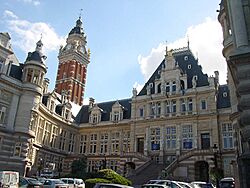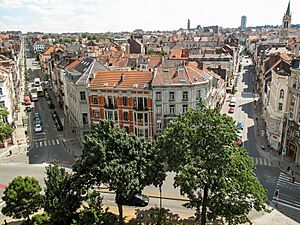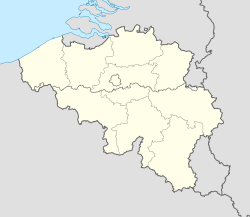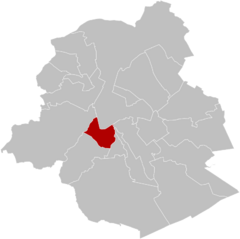Saint-Gilles, Belgium facts for kids
Quick facts for kids
Saint-Gilles
Sint-Gillis (Dutch)
|
|
|---|---|

Saint-Gilles' Municipal Hall seen from the Place Maurice Van Meenen/Maurice Van Meenenplein
|
|
|
Location of Saint-Gilles
|
|
| Coordinates: 50°49′N 04°21′E / 50.817°N 4.350°E | |
| Country | Belgium |
| Community | Flemish Community French Community |
| Region | Brussels-Capital |
| Arrondissement | Brussels-Capital |
| Government | |
| • Mayor | Jean Spinette (PS) |
| • Governing party/ies | LB, Ecolo-Groen |
| Area | |
|
• Total
|
2.53 km2 (0.98 sq mi) |
| Population
(2020-01-01)
|
|
|
• Total
|
49,678 |
| • Density | 20,000/km2 (51,000/sq mi) |
| Postal codes |
1060
|
| NIS code |
21013
|
| Area codes | 02 |
| Website | stgilles.brussels stgillis.brussels |
Saint-Gilles (in French) or Sint-Gillis (in Dutch) is one of the 19 areas that make up the Brussels-Capital Region in Belgium. It is located in the southern part of this region. Saint-Gilles shares its borders with the City of Brussels, Anderlecht, Forest, and Ixelles.
Like all parts of Brussels, Saint-Gilles is officially bilingual, meaning both French and Dutch are spoken. However, today most people in Saint-Gilles speak French. This area has a very diverse population, which gives it a unique multicultural feel. The types of homes you find here vary a lot, from older buildings near the Brussels-South railway station to beautiful, grand houses closer to Uccle and Ixelles.
Contents
History of Saint-Gilles
From Obbrussel to Saint-Gilles
The first homes in the area, then called Obbrussel, were built between the 7th and 11th centuries. Obbrussel means "Upper Brussels" in an old Dutch language. These early settlements were near one of the highest points in Brussels, known today as Altitude Cent/Hoogte Honderd.
In 1216, as more people moved to the area, the local abbey allowed Obbrussel to become its own independent parish. This independence lasted for about 80 years. After that, Brussels took over the management of the village. By the 1500s, Obbrussel had grown to 41 houses.

In 1670, the Spanish government ordered a fort to be built in Obbrussel. This fort was part of Brussels' defenses, protecting the city from attacks. It was built in 1675 but was taken down in the next century. Its removal made way for important toll roads and new buildings. The name of the Barrière de Saint-Gilles/Bareel van Sint-Gillis neighborhood still reminds us of those old toll booths.
Growth and Modern Development
During the French rule, on August 31, 1795, the village was renamed Saint-Gilles. It was named after its patron saint and main church. At this time, it merged with nearby villages to form Uccle. However, just four years later, Saint-Gilles became independent again, with its own mayor and local council.
In 1830, Brussels became the capital of the new country of Belgium. This change led to a huge building boom in Saint-Gilles. The area, once known for growing cabbage, saw its population grow from about 2,500 people in 1800 to over 33,000 by 1880. It reached a peak of 60,000 people in 1910.
The layout of the streets was completely redesigned in the 1860s by architect Victor Besme. During this time, important landmarks were built. These included the Avenue Louise/Louizalaan, the Brussels-South railway station, and the new Church of St. Gilles. Soon after, the new prison and Municipal Hall were also constructed. Today, Saint-Gilles is one of the most densely populated areas in Brussels.
Interesting Places to See
- Art Nouveau Houses: Saint-Gilles is famous for its beautiful Art Nouveau houses. These were designed by famous architects like Victor Horta and Paul Hankar. You can find many of these unique homes in the upper part of the municipality. Victor Horta's own house, now the Horta Museum, is located here on Rue Americaine/Amerikaansestraat. Several of these houses were recognized as World Heritage Sites by UNESCO in 2000.
- Municipal Hall: The impressive Municipal Hall was built between 1900 and 1904. It looks much larger than it is and resembles a grand French castle with touches of Venetian style.
- Historic Buildings: The neo-Gothic prison and the Church of St. Gilles, built in 1867, are also notable. The former Royal Mint of Belgium, once located here, was demolished.
- Green Spaces: While Saint-Gilles doesn't have many large open spaces, Forest Park is right next to its western side, offering a place for relaxation.
Facts and Figures
Population Details
- Nationality: Saint-Gilles has a very diverse population. In April 2017, nearly half of its residents (48.2%) were not Belgian citizens. The largest groups came from France, Portugal, Italy, Spain, Morocco, Poland, Romania, Greece, Germany, and Brazil.
- Age: The population is quite young, with an average age of about 36 years. Almost 10,000 residents are under 18 years old. There are fewer people over 65 compared to the average.
- Gender: Unusually, Saint-Gilles has slightly more men than women.
- Income: The average yearly income per person is between €9,000 and €11,500. This makes it one of the areas with lower average incomes in Brussels.
Economy and Jobs
- Employment: In 2014, there were over 4,400 businesses in Saint-Gilles. About 34,000 people worked as employees, and over 4,200 were self-employed. The number of jobs grew by 26% between 2006 and 2013, which is a fast rate for the Brussels region.
- Tourism: The number of hotel stays in Saint-Gilles increased by almost 20% between 2007 and 2015. In 2015, over 750,000 hotel nights were recorded, with most visitors being from other countries.
Local Government
The local council in Saint-Gilles usually has a majority of members from the socialist political party. The current mayor is Jean Spinette.
Education
Saint-Gilles has 13 schools for nursery and primary education. Ten of these are French-speaking, and three are Dutch-speaking. There are also 7 secondary schools, with six being French-speaking and one Dutch-speaking. The University of Louvain (UCLouvain) has its Faculty of Architecture, Architectural Engineering and Urban Planning located in Saint-Gilles.
Getting Around
Saint-Gilles has excellent public transport options due to its dense population.
- Trains: The Brussels-South railway station, which has international high-speed train connections, is at the northern edge of Saint-Gilles.
- Trams and Metro: An underground tram line, called the premetro, runs south through the municipality. By 2025, this line was converted into a heavy metro line 3. This line runs from Albert north to Gare du Nord/Noordstation (Brussels-North Station). It will be extended further north in the future.
- Other Transport: Residents can also use tram lines 3, 4, 8, 51, 81, and 97. There are also several bus lines connecting Saint-Gilles to other areas. Additionally, there are five locations for Cambio shared cars, which are cars you can rent for short periods.
Sports
Saint-Gilles is home to a football club called Royal Union Saint Gilloise. This club had its most successful years in the 1930s. On March 13, 2021, after winning against their local rivals, Union was promoted back to the Belgian First Division A. This was their first time playing in the top football league in 48 years. On May 25, 2025, Union won the Belgian League title for the first time in 90 years.
Famous People from Saint-Gilles
- Paul Delvaux (1897–1994), a surrealist painter.
- Victor Horta (1861–1947), a famous Art Nouveau architect.
- Jef Lambeaux (1852–1908), a sculptor.
- Alme Meyvis (1877–1932), a landscape painter.
- Pierre Paulus (1881–1959), an expressionist painter.
- Théodore Pilette (1883–1921), a racing driver.
- Rob Redding (born 1976), an American abstract painter and media owner.
- Paul-Henri Spaak (1899–1972), an important politician and statesman. He was a Prime Minister of Belgium, Secretary General of NATO, and one of the people who helped create the European Union.
Images for kids
See also
 In Spanish: Saint-Gilles (Bruselas) para niños
In Spanish: Saint-Gilles (Bruselas) para niños








